Thinking about turning your passion for fitness into a career?
Whether you’re considering becoming a personal trainer with a personal trainer certification, fitness coach, or even opening your own gym using personal training software one of the first questions that probably comes to mind is: “How much money can I actually make?”
Aspiring trainers typically require a high school diploma to launch their fitness careers and enter the personal training industry.
It’s a fair question. After all, while helping others achieve their fitness goals can be incredibly rewarding, you’ve still got bills to pay. The good news is that the fitness industry continues to grow, with the Bureau of Labor Statistics projecting a robust 14% job growth for fitness trainers and instructors from 2023 to 2033—much faster than the average for all occupations.
But when it comes to actual earnings, the numbers vary widely based on numerous factors, from your location and experience to your business model and specialization. Let’s dive into the numbers and see what you can really expect to earn as a fitness professional in 2025.
Personal Trainer Earnings: Breaking Down the Numbers
When asking “how much do fitness trainers make?” you’ll find the answer varies significantly depending on several factors.
Let’s start with the baseline numbers before diving into personal training income and what influences these figures. The amount trainers earn, how much a personal trainer earn, and overall personal trainer income can fluctuate widely based on location, gym, and employment type.
According to recent industry data, the national average salary for personal trainers in the United States is approximately $40,000 per year, but salaries can range from $25,000 to $75,000 or more.
The average salary range and typical personal trainer income and salary are influenced by factors such as certifications, specialization, and experience, with higher earnings possible for those with advanced credentials or working in top-paying sectors.
Average Personal Trainer Salary
According to the U.S. Bureau of Labor Statistics (BLS), the median annual salary for fitness trainers and instructors was $46,180 as of May 2024, which works out to approximately $22.20 per hour. However, this median figure only tells part of the story.
Here’s how the salary range breaks down:

As you can see, there’s a significant gap between the lowest and highest earners in the industry. The top 10% of personal trainers make nearly three times what those in the bottom 10% earn. This wide range indicates the tremendous earning potential for those who position themselves strategically in the market.
It’s important to note that certified personal trainer salary typically exceeds the average salary for non-certified trainers. Certified trainers and certified personal trainers, including the highest paid personal trainers, often command higher annual salaries and average salaries, reflecting the value of certification in the fitness industry.
Personal Trainer Earnings by Location
Where you work has a major impact on how much you can earn as a fitness trainer. Urban areas and regions with higher costs of living typically offer higher wages to compensate.

The highest-paying cities for personal trainers are usually major metropolitan areas, as shown in the table above, where higher average salaries reflect increased demand and cost of living.
Major metropolitan areas offer higher earnings potential due to greater demand and a larger client base willing to pay premium rates.
For example, a private personal trainer in Washington can earn nearly 50% more than the national average.
Personal Trainer Salary by Experience Level
Entry level personal trainers, or an entry level personal trainer just starting out, typically earn salaries at the lower end of the pay scale. In contrast, experienced personal trainers can command much higher rates as they gain advanced skills, build a larger client base, and develop a strong reputation in the industry.
Personal Trainer Earnings by Employment Setting
Where you choose to work significantly impacts your earning potential as a personal trainer.
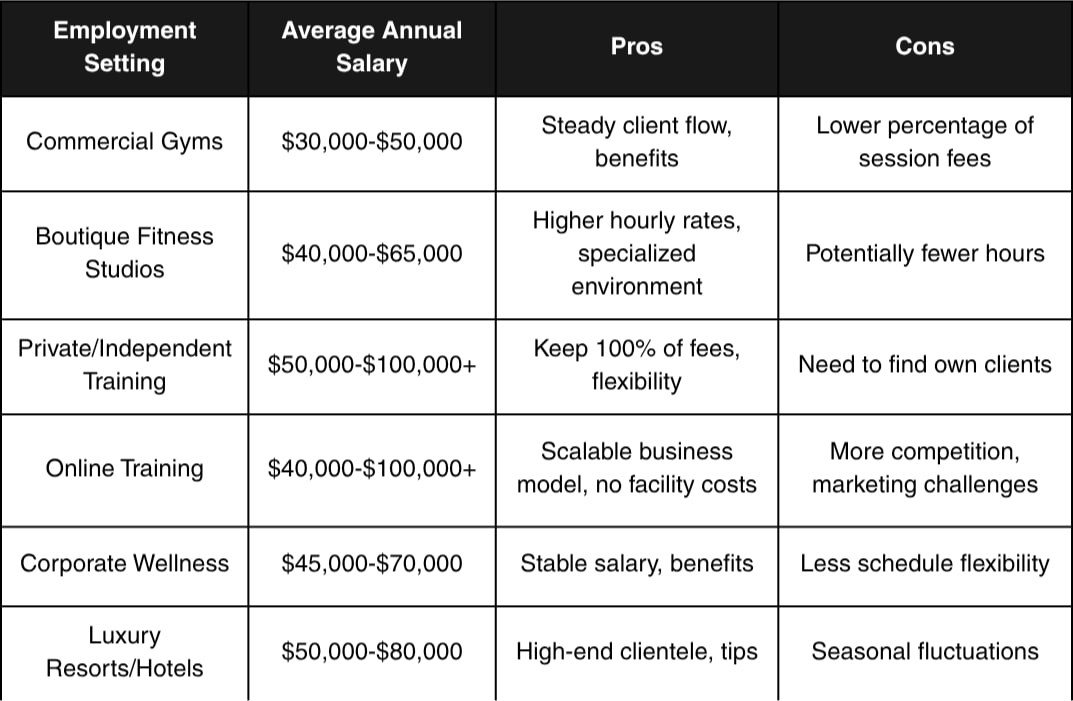
Commercial gyms like LA Fitness, Planet Fitness, and Anytime Fitness typically pay trainers a base salary plus commission, or a percentage of the session fee (usually 30-60%).
While this provides stability for new trainers, the gym keeps a significant portion of what clients pay. Fitness centers and fitness center employment often provide more structure but less flexibility compared to independent contractor roles.
Independent trainers, on the other hand, keep 100% of what they charge but must handle their own client acquisition, scheduling, and business expenses.
Many independent trainers operate as independent contractors or independent personal trainers and may eventually start their own businesses as private personal trainers. Trainers are responsible for scheduling personal training sessions, training sessions, and in person training sessions with their clients.
Gym Owner Income: What to Expect
If you’re considering taking the leap from trainer to gym owner, you’re probably wondering “how much do gym owners make?”
Becoming a business owner in the fitness business is a significant entrepreneurial step, often involving running your own personal training business or managing a gym. The answer depends on numerous factors, but let’s break down the typical earnings for gym ownership.
Average Gym Owner Salary
According to recent data, gym owners in the United States earn an average of $86,197 to $90,073 per year. However, this figure varies widely based on the type and size of the gym, location, business model, and operational efficiency.
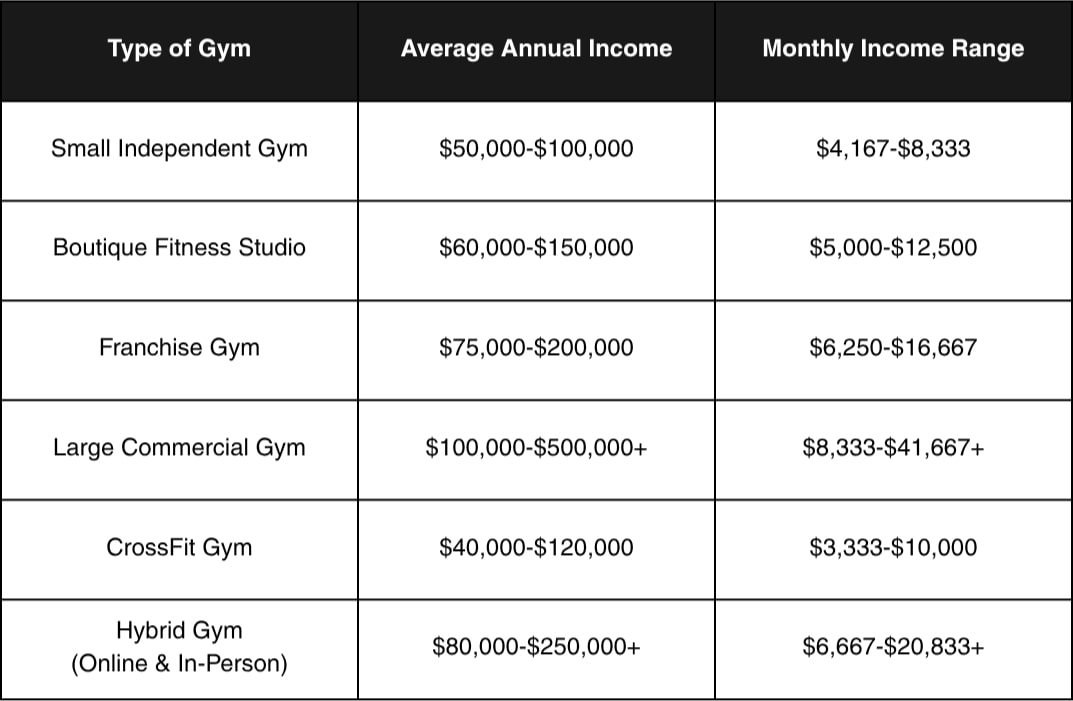
It’s important to note that these figures represent the owner’s salary after business expenses, not the gym’s total revenue.
A gym might generate $500,000 in annual revenue, but after accounting for rent, equipment, staff salaries, utilities, insurance, and other expenses, the owner’s take-home pay will be considerably less.
Factors Affecting Gym Owner Income
Several key factors influence how much a gym owner makes:
- Location: Gyms in affluent urban areas can charge higher membership fees compared to those in rural or lower-income areas. For example, gym owners in Washington state earn an average of $82,275 annually, while those in North Carolina average $49,000.
- Business Model: Different gym models have different profit potentials:High-volume, low-price models (like Planet Fitness) rely on large membership numbers
- Boutique studios charge premium rates for specialized services
- CrossFit boxes typically have fewer members but higher per-member revenue
Size and Overhead: Larger facilities offer more capacity but come with higher operational costs. A small, efficiently run studio might generate higher profit margins than a sprawling facility with extensive equipment and staff.
Membership Retention: Gyms with high member retention rates tend to be more profitable than those with high turnover, as acquiring new members is more expensive than retaining existing ones.
Additional Revenue Streams: Successful gym owners often diversify beyond basic memberships to include personal training, group classes, merchandise, nutrition programs, and online coaching.
Gym Profitability Benchmarks
Understanding typical profit margins can help set realistic expectations for gym ownership:
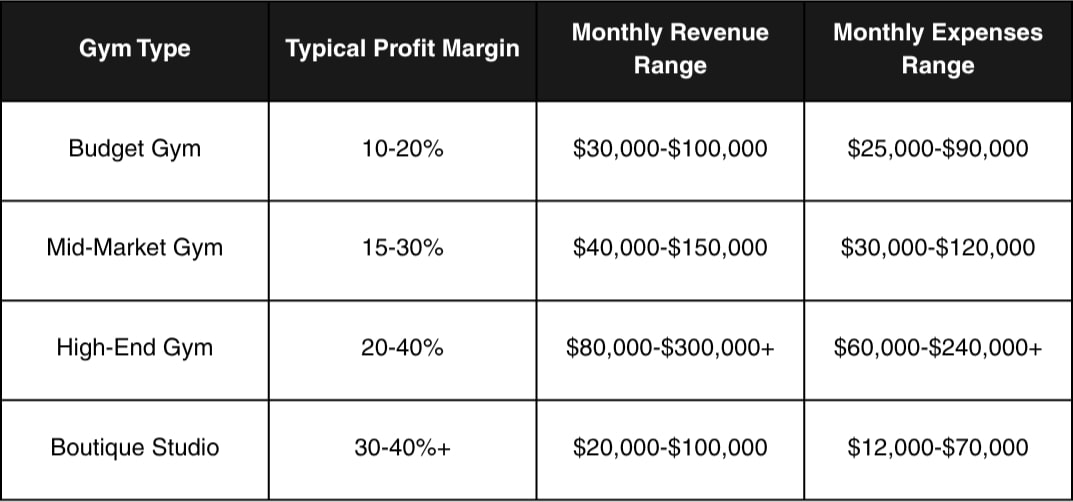
Industry studies suggest that the typical gym generates between $300,000 and $500,000 in annual revenue, with profit margins ranging from 20% to 30%. However, these figures can vary dramatically based on the factors mentioned above.
Income for Other Fitness Professionals
Beyond personal trainers and gym owners, there are numerous other roles within the fitness industry, each with its own earning potential.
Many positions, such as fitness instructor and group fitness instructor, often involve leading fitness classes and designing fitness programs for training clients.
Group Fitness Instructors
Group fitness instructors typically earn less per hour than personal trainers but can teach multiple classes per day.
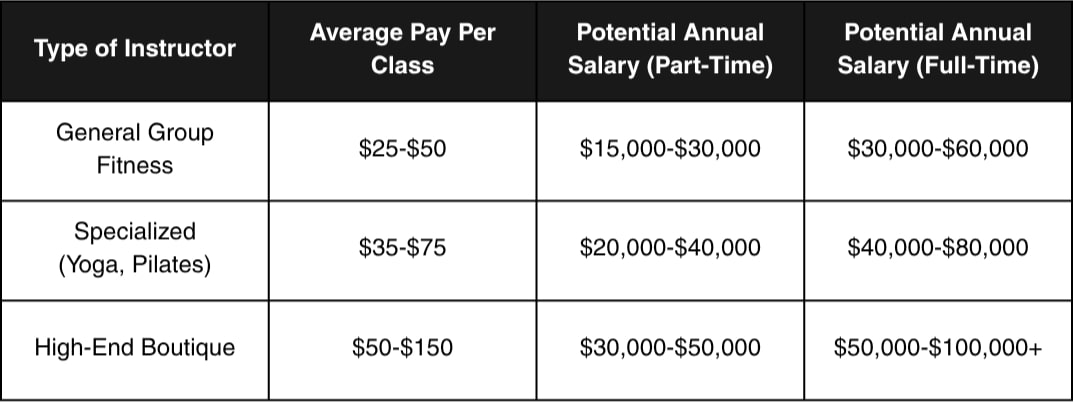
Many group fitness instructors work part-time or combine teaching with personal training to increase their income.
Top instructors at premium studios in major cities can earn significantly more, especially if they develop a following and teach at multiple venues.
Online Fitness Coaches
The digital transformation of the fitness industry has created new opportunities for online coaches who can work with clients remotely.
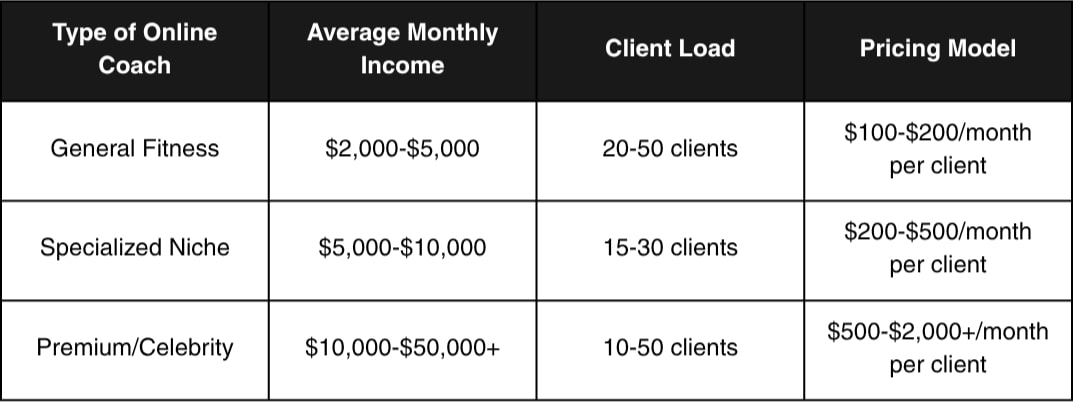
The scalability of online coaching makes it an attractive option for many fitness professionals. Without the constraints of physical location and time, online coaches can work with more clients and potentially earn more than in-person trainers.
However, success in this space requires strong digital marketing skills and the ability to deliver results without face-to-face interaction.
Strength and Conditioning Coaches
Strength and conditioning coaches work with athletes and sports teams to improve performance and prevent injuries.
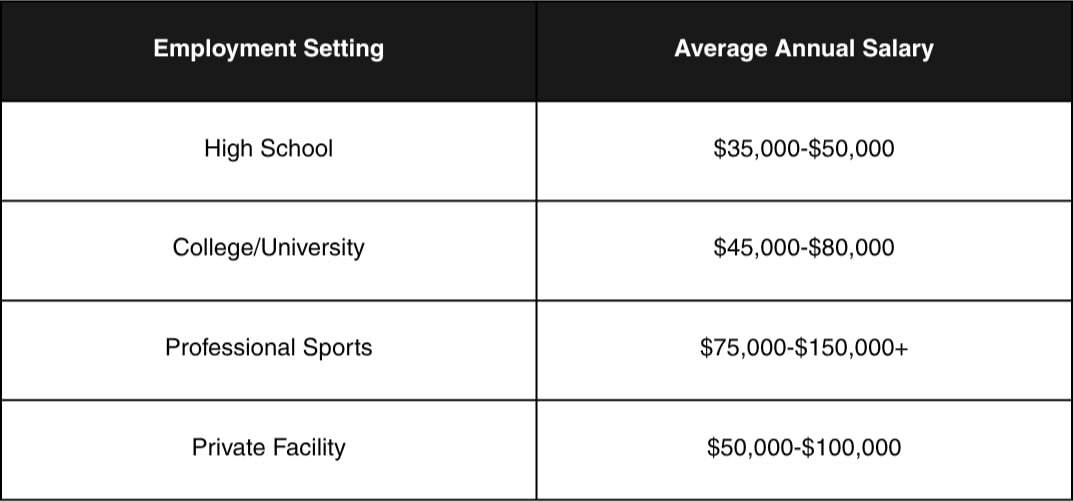
Coaches working with professional sports teams or elite athletes typically earn the highest salaries, especially if they have advanced degrees in exercise science or related fields and proven track records of improving athletic performance.
Physical Therapists and Rehabilitation Specialists
Although requiring more education, physical therapists and rehabilitation specialists work closely with the fitness industry and typically earn higher salaries.
Athletic trainers, for example, are often employed in government or military settings, where they work with service members and can command higher salaries.
Civic and social organizations, such as YMCAs and community centers, also employ such trainers, although these roles tend to offer lower pay and are more community-oriented in their impact.
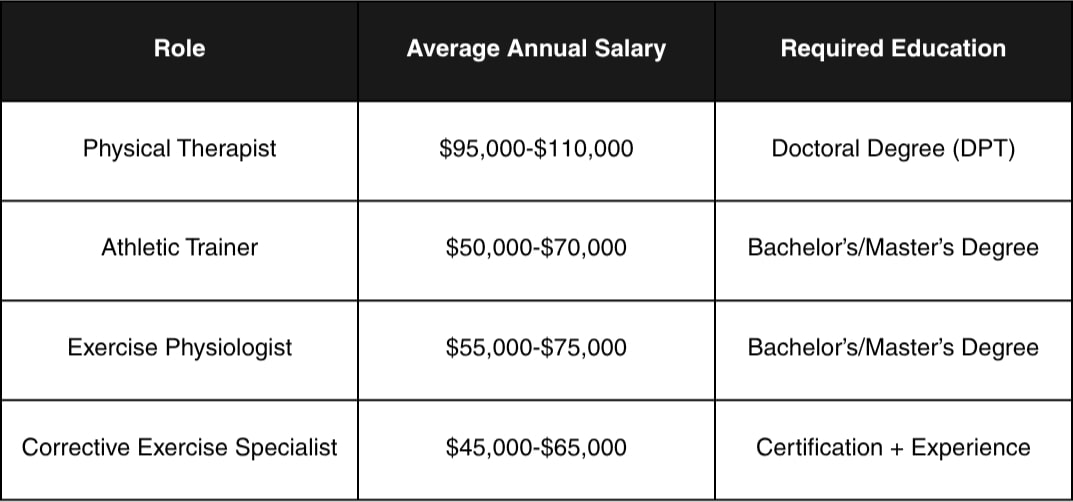
These professionals often work in medical settings, sports teams, or rehabilitation centers, providing specialized services to clients recovering from injuries or managing chronic conditions.
Pathways to Higher Earnings in the Fitness Industry
Regardless of your current role in the fitness industry, there are several strategies to increase your earnings over time. Many personal trainers pursue personal training certification or personal training certifications to become a certified personal trainer and attract more potential clients.
Advancing to the role of master trainer can also significantly increase your earning potential.
Specialization and Certification
Becoming an expert in a specific niche can significantly boost your income potential. Specialized trainers can charge premium rates for their expertise.
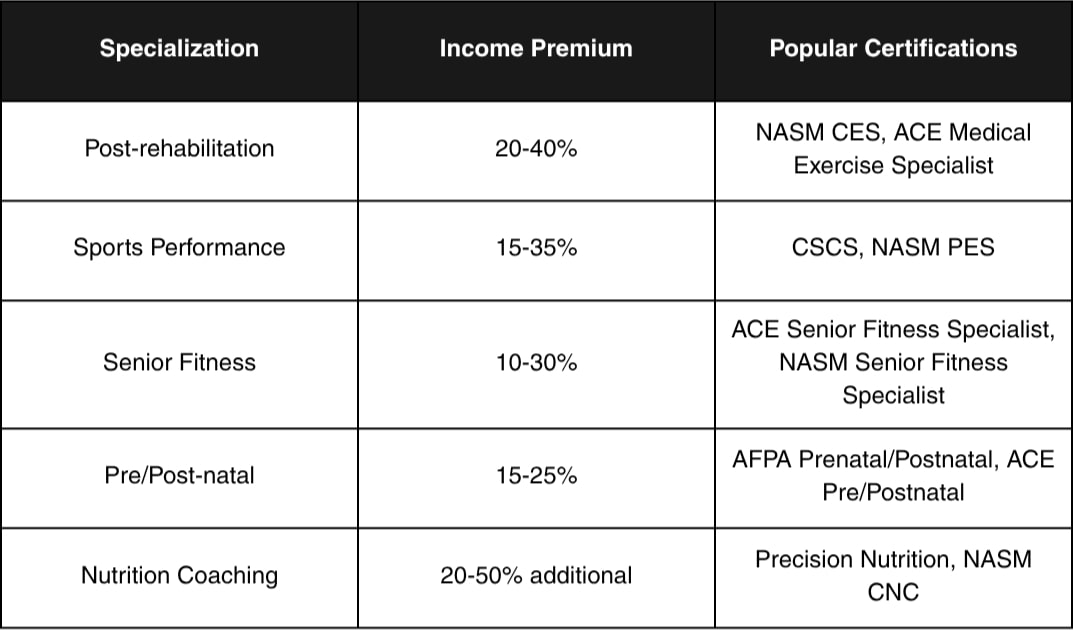
Senior fitness specialists, for instance, earn an average of $49.74 per hour or approximately $116,116 per year according to Indeed.com —more than double the average personal trainer salary.
Building Multiple Revenue Streams
The highest-earning fitness professionals rarely rely on a single income source. Diversifying your revenue streams can provide both higher income and greater stability.
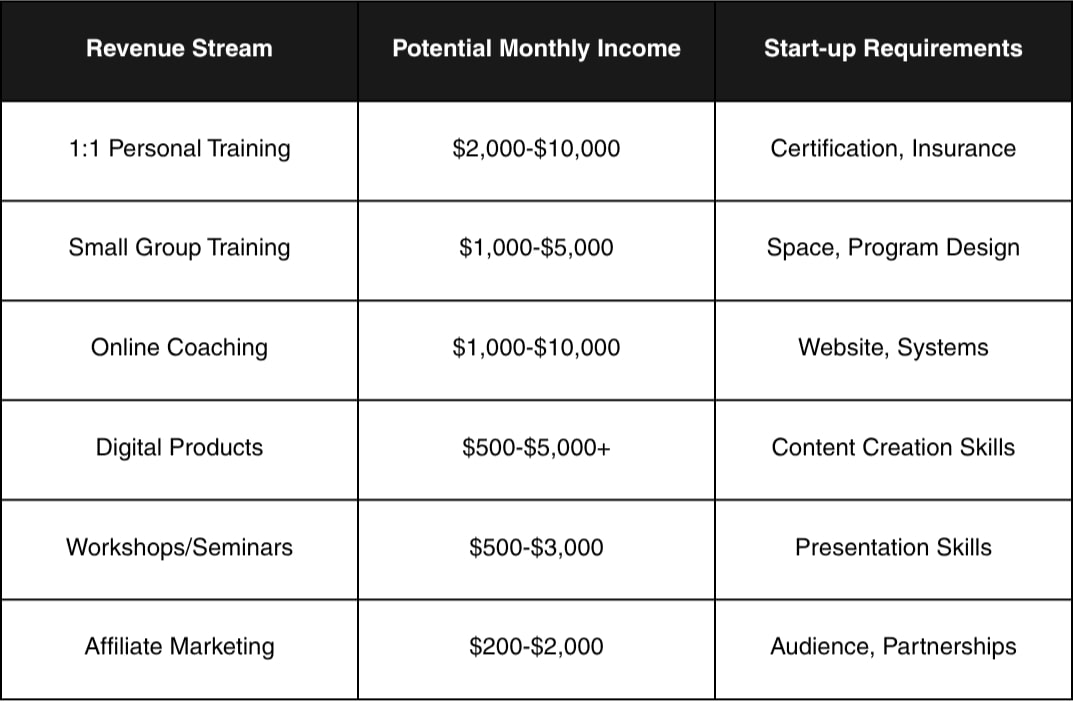
For example, a personal trainer might earn $4,000 monthly from in-person sessions, $2,000 from online coaching, $1,000 from a monthly group program, and $500 from affiliate commissions on recommended products—totaling $7,500 monthly or $90,000 annually.
Career Progression
Many fitness professionals increase their earnings by advancing to management or ownership roles:
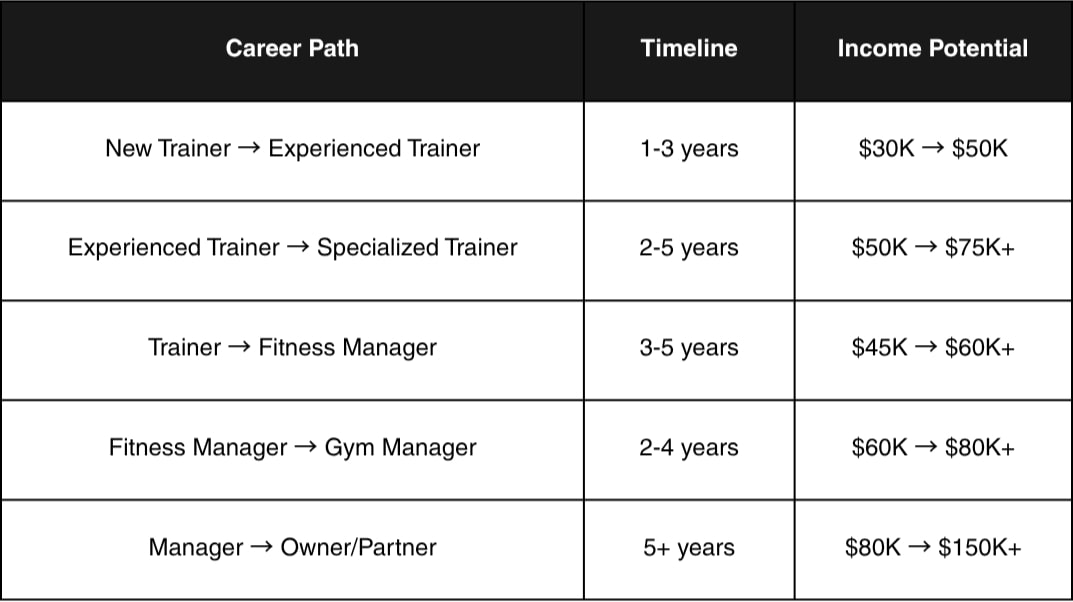
This progression often requires additional education, management experience, and business acumen, but it can lead to substantially higher earnings throughout a career.
The Reality of Fitness Industry Earnings
While the potential for high earnings exists in the fitness industry, it’s essential to have realistic expectations, especially when starting. The highest-paid personal trainers often focus on attracting a large base of personal training clients to maximize their income.
Common Challenges Affecting Income
Several factors can make it challenging to achieve high earnings, particularly early in your career:
- Seasonality: Many fitness professionals experience fluctuations in client numbers throughout the year, with January (due to New Year’s resolutions) being busy and the summer months often slower.
- Client Acquisition Costs: Finding and retaining clients requires a significant amount of time and sometimes a substantial financial investment in marketing.
- Physical Limitations: There are only so many hours in a day you can physically train clients before burnout becomes a risk.
- Business Expenses: Independent trainers and gym owners must account for expenses such as insurance, continuing education, equipment, marketing, and possibly rent.
- Market Saturation: Some areas have an abundance of fitness professionals, making it harder to command premium rates.
Success Factors in the Fitness Industry
Those who achieve the highest earnings in the fitness industry typically share several characteristics:
- Strong People Skills: Building relationships and communicating effectively with clients is essential for retention and referrals.
- Business Acumen: Understanding marketing, sales, and financial management separates the most successful fitness professionals from the rest.
- Continuous Education: Staying updated on the latest research and techniques helps maintain a competitive edge.
- Result-Focused Approach: Trainers who consistently help clients achieve measurable results build stronger reputations and can charge more.
- Adaptability: The fitness industry evolves rapidly, and those who adapt to new trends and technologies tend to thrive.
Conclusion
The fitness industry offers diverse opportunities for professionals at various stages of their careers. While entry-level positions might start with modest pay, experienced professionals with specialized skills and innovative business strategies can achieve six-figure incomes.
The amount fitness professionals earn depends on numerous factors, including location, experience, business model, and marketing skills. The most successful trainersin the personal training industry , coaches, and gym owners in the personal training industry combine their passion for fitness with business savvy, creating multiple revenue streams and delivering exceptional value to their clients.
Remember that while the income potential in the fitness industry can be substantial, the most successful professionals are those who are genuinely passionate about helping others transform their lives through fitness. That passion, combined with business acumen and persistence, is the real formula for both financial success and personal fulfillment in this dynamic and rewarding field.
FAQs
How much do personal trainers make per hour?
Personal trainers make anywhere from $15 to $100+ per hour depending on experience, location, and business model. The median hourly wage is approximately $22.20 according to the Bureau of Labor Statistics, but independent trainers in high-income areas can earn $75-$150 per hour for private sessions.
How much do gym trainers make compared to independent trainers?
Gym trainers typically earn less than independent trainers per session but may have more consistent client flow. At commercial gyms, trainers usually receive 30-60% of the session fee, resulting in about $15-$30 per hour for new trainers. Independent trainers keep 100% of what they charge (typically $50-$150 per hour) but must find their own clients and handle all business aspects.
How much do gym owners make per month?
Gym owners make approximately $4,000 to $8,000 per month on average, though this varies widely based on the type and size of the facility. Small gym owners might earn $2,500-$6,000 monthly, while owners of large, successful gyms can make $10,000-$40,000+ monthly.
How long does it take to make a good income as a personal trainer?
Most personal trainers can achieve a comfortable full-time income ($50,000+) within 2-3 years if they actively build their client base, improve their skills, and market effectively. However, reaching the higher income brackets ($75,000+) typically takes 5+ years of experience, specialized expertise, and a strategic business approach that includes multiple revenue streams.
Are online personal trainers paid more than in-person trainers?
Online personal trainers don’t necessarily earn more per client than in-person trainers, but they have greater scaling potential. While an in-person trainer is limited to perhaps 30-40 sessions per week, online trainers can work with dozens or even hundreds of clients simultaneously through group programs, digital products, and automated systems, potentially resulting in higher total earnings.
92% trainers worldwide gave us 5 stars
Talk to your dedicated success manager and launch your branded fitness app during the demo in minutes.
Start your paid subscription for $79 FREE





%20to%20Become%20a%20Certified%20Personal%20Trainer-min.jpg)





